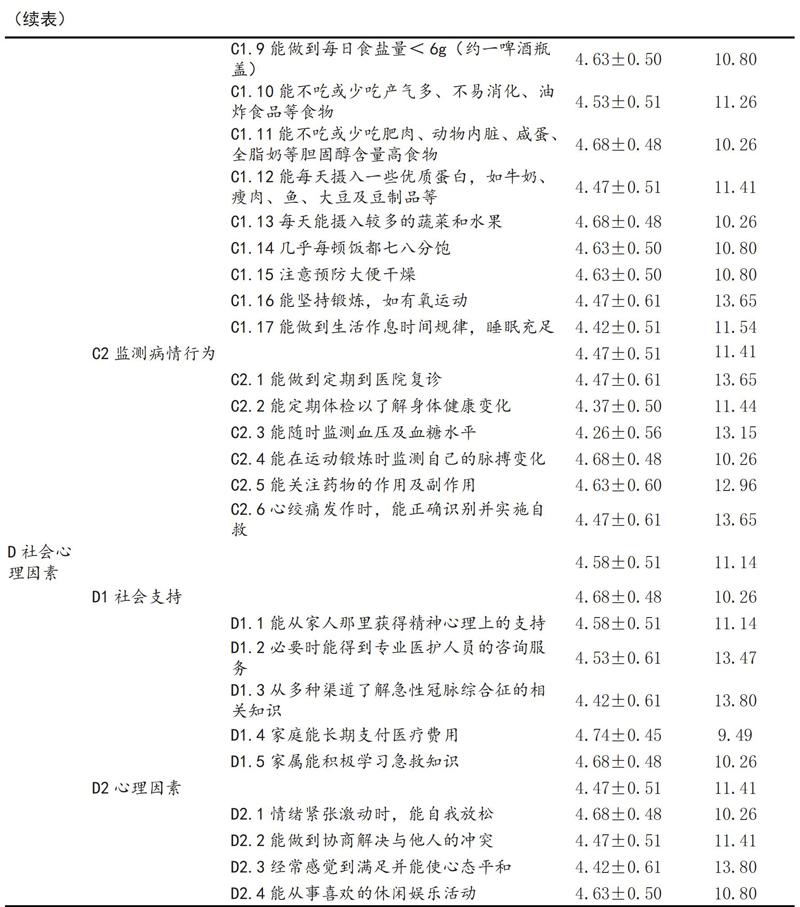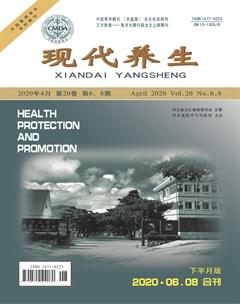急性冠脉综合征患者居家安全风险评价指标体系构建
赵萍 郑军 刘洁 焦娜娜 杨琨 邢凤梅


摘要 目的:探討构建急性冠脉综合征患者居家安全风险评价指标体系,为有效评价提供依据。方法:在查阅相关文献、质性访谈的基础上,经小组讨论,充分分析急性冠脉综合征患者居家安全风险因素,以“风险管理理论”和“知信行理论”作为理论框架,形成急性冠脉综合征患者居家安全风险评价指标体系的条目池。于2019年1月-2月,通过德尔菲法进行专家函询,采用目的抽样选取心血管内科医疗及护理领域专家19名,进行2轮咨询确定评价指标体系。结果:两轮专家的积极系数分别为100%和95%,经过第一轮专家函询,增加指标6项、修改5项、删除7项;第二轮函询后,一二三级指标均未增减,修改2项,一、二、三级指标的Kendall's W分别为0.229、0.356、0.295(P<0.001),变异系数为0.065-0.138,根据筛选标准,综合专家函询意见后,最终形成急性冠脉综合征患者居家安全风险评价指标体系包括一级指标4个、二级指标10个、三级指标54个。结论:本研究构建的急性冠脉综合征患者居家安全风险评价指标体系专家意见的协调程度好,具有科学性和实用性。
关键词 急性冠脉综合征;居家安全风险;德尔菲法
中图分类号 R541.4 文献标识码 B 文章编号 1671-0223(2020)06-061-05
STUDY ON THE ESTABLISHMENT OF HOME SAFETY RISK EVALUATION INDEX SYSTEM FOR PATIENTS WITH ACUTE CORONARY SYNDROME Zhao Ping,Zheng Jun,Liu Jie,et al.Nursing and Rehabilitation College of North China University of Science and Technology,Hebei Tangshan 063210;Tangshan People's Hospital,Tangshan 063000,China
Abstract Objective To explore the establishment of home safety risk assessment index system for patients with acute coronary syndrome .Methods On the basis of consulting relevant literature and qualitative interviews, the risk factors of home-based safety for patients with acute coronary syndrome were fully analyzed through group discussion, and an entry pool of home-based safety risk assessment index system for patients with acute coronary syndrome was formed with "risk management theory" and "knowledge, faith and behavior theory" as the theoretical framework.From January to February 2019, expert consultation was conducted through the Delphi method, and 19 experts in the field of cardiovascular medicine and nursing were sampled by purpose to determine the evaluation index system through two rounds of consultation.Results The positive coefficients of the two rounds of experts were 100% and 95% respectively. After the first round of expert consultation, 6 indicators were added, 5 indicators were modified and 7 indicators were deleted.After the second round of enquiry, just a little three indexes did not increase or decrease, modify the two, one, two, three indicators of Kendall 's W were 0.229, 0.356, 0.295 (P < 0.001), the variation coefficient is 0.065 ~ 0.138, according to the screening criteria, after comprehensive enquiry for experts, eventually form home security risk evaluation index system in patients with acute coronary syndromes including indicators 4, 10, three-level index 54 secondary indicators.Conclusion The evaluation index system of home safety risk for patients with acute coronary syndrome constructed in this study has a good degree of coordination of expert opinions, which is scientific and practical.
2.5.2 第2轮函询结果 第2轮函询结束后,一、二、三级指标均未增减,结合专家意见,修改三级指标2项,“A3.3了解如何预防急性冠脉综合征复发和其他的心血管事件吗”修改为“了解如何预防急性冠脉综合征复发及相关的心血管事件吗”,“B1.4应该控制体重增长”修改为“应该控制体重”。最终形成急性冠脉综合征患者居家安全风险评价指标体系一级指标4个、二级指标10个、三级指标54个,见表1。
3讨论
3.1急性冠脉综合征患者居家安全风险评价指标体系内容的可靠性
本研究参与完成2轮函询问卷的19名心内科的临床医护专家在专业领域具有良好的代表性。2轮函询专家的积极系数分别为100%和95%,说明函询专家对本研究的积极性较高,关注较多。专家中硕士及以上学历者13名(68.42%),副高及以上职称者14名(73.68%),平均工作年限19.32±3.28年,表明函询专家对本领域研究内容有较丰富的实践经验和深厚的理论知识。第1轮函询中有12名专家提出23条建议,第2轮中有2名专家提出2条文字建议,表明函询专家对本研究指标的意见趋于一致。此外,本研究两轮函询专家的权威系数为0.860和0.866,专家权威系数较高,确保了函询结果的可靠性。
3.2急性冠脉综合征患者居家安全风险评估具有实用性
家庭环境安全对于患者康复尤为重要,与在醫疗机构中进行康复的患者相比,其居家康复涉及的护理人员更少、更缺乏专业性,造成患者安全问题的外在因素更多,缺乏完善的安全预防和突发事件处理系统[6],危及患者的生命安全。本研究通过半结构式访谈心内科医护人员并听取其意见,由相关领域的资深专家在函询过程中给予可行性评定,多方面保证了评价指标体系的实际可用性。构建的评价指标体系中,涵盖了防范知识、防范态度、防范行为和社会心理4个维度,能够较为全面的评估急性冠脉综合征患者的居家安全风险。Aparan[7]认为能够控制和管理风险因素的有效途径即为:根据有效评估结果制定风险应对的措施。重视急性冠脉综合征患者居家安全风险因素的评估,在危险发生之前,前瞻性采取积极有效的管理方法和干预措施,减少危害患者健康风险的存在,提升患者的居家康复安全指数,提高患者的生活质量水平[8-9]。
4参考文献
[1]Sumner J A , Kronish I M , Chang B P , et al. Acute stress disorder symptoms after evaluation for acute coronary syndrome predict 30-day readmission[J]. International Journal of Cardiology, 2017:S0167527316329473.
[2]王伟.急性冠脉综合征患者焦虑抑郁状态、睡眠质量、再入院率的相关性研究[D].济南:山东大学,2019.
[3]Mofina AM,Guthrie DM. A comparison of home care quality indicator rates in two Canadian provinces[J].BMC Health ServRes,2014,14(1):37.
[4]孟楠楠,张金华.老年脑卒中患者居家安全隐患及需求分析[J].中国卫生产业,2016,13(15): 69-71.
[5]Jencks SF, Williams MV, Coleman EA.Rehospitalizations among patients in the Medicarefee-for-service program[J].New England Journalof Medicine, 2009, 360(14): 1418-1428.
[6]邓璐,鲁春桃,胡银环,等.国内外患者居家安全现状及未来发展趋势分析[J].中国医院,2018,22(10):40-42.
[7]Aparan G.Risk management and simulation[M].boca Raton:CRC Press,2014.
[8]Romero Emily K,Abdalla Marwah,Thanataveerat Anusorn,et al. Short sleep duration after hospital evaluation for acute coronary syndrome is associated with increased risk of 6-Month readmission.[J]. Psychosomatic Medicine,2020,82(1):26-28.
[9]朱亮,杨小娇,邢凤梅.农村高血压老年患者居家安全风险与社会支持及抑郁关系[J].中国公共卫生,2018,34(11):1555-1558.
[2020-03-10收稿]

